Did you know that Morocco attracts millions of travelers each year with its unique blend of ancient traditions and breathtaking landscapes? A 7-day trip to this North African country can be a truly immersive experience, allowing visitors to explore bustling medinas, serene desert landscapes, and majestic mountains.
A well-crafted itinerary is essential to making the most of your time in Morocco. With 7 days, you can travel through iconic cities like Marrakech and Fez, experience the natural beauty of the Atlas Mountains, and marvel at the mesmerizing Sahara Desert.
This comprehensive guide provides a day-by-day experience of Morocco, balancing must-see attractions with cultural insights and practical tips, ensuring an unforgettable trip to this captivating country.
Key Takeaways
- Discover the ideal 7-day Morocco travel plan
- Explore iconic cities, mountains, and deserts
- Immerse in local culture with practical tips
- Experience the best of Morocco’s diverse landscapes
- Make the most of your time with a well-planned itinerary
Discovering Morocco: What Makes It a Must-Visit Destination
Morocco is a treasure trove of experiences, waiting to be explored by travelers from around the globe. With its unique blend of cultures, stunning landscapes, and vibrant cities, it’s no wonder that Morocco has become a favorite destination for many.
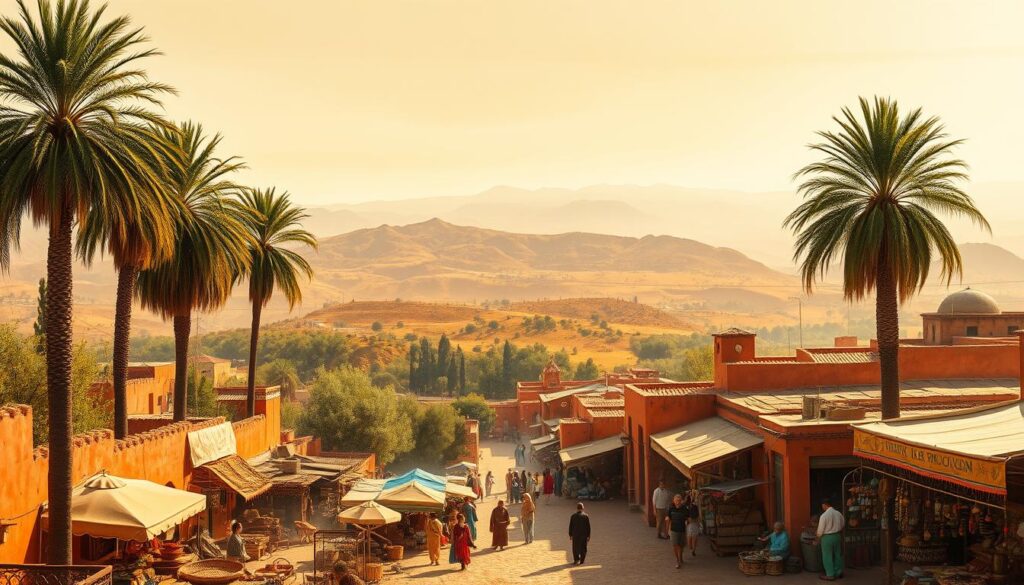
The Cultural Tapestry of Morocco
Morocco’s rich cultural heritage is shaped by Berber, Arab, and French influences, creating a unique tapestry of traditions, architecture, and cuisine. The country’s cultural diversity is reflected in its vibrant cities, where visitors can experience the local way of life. For instance, the city of Marrakech is a favorite place for photographers due to its inspiring colors and textures.
The blend of cultures is evident in the local cuisine, which is a fusion of flavors and spices. Visitors can indulge in traditional Moroccan dishes, such as tagines and couscous, which are often served with a warm welcome.
Geographic Diversity: From Mountains to Desert
Morocco’s geographic diversity is breathtaking, with landscapes ranging from the snow-capped Atlas Mountains to the golden Sahara dunes and the rugged Atlantic coastline. This diversity makes Morocco an attractive destination for travelers who want to experience different landscapes in a relatively compact country.
The varied landscape also supports a range of outdoor activities, from hiking in the mountains to camel trekking in the desert. Visitors can explore the natural beauty of Morocco, making it a perfect destination for nature lovers.
Why 7 Days Is the Perfect Introduction
A 7-day itinerary provides the perfect introduction to Morocco, allowing travelers to experience the country’s highlights without feeling rushed or overwhelmed. Over 7 days, visitors can explore the vibrant cities, immerse themselves in the local culture, and witness the stunning natural beauty of the country.
This carefully planned itinerary balances city exploration, cultural immersion, and natural wonders, giving first-time visitors a comprehensive taste of what makes Morocco special. Whether it’s exploring the souks of Marrakech or relaxing in a desert camp, 7 days in Morocco is an unforgettable experience.
Planning Your Moroccan Adventure: Essential Pre-Trip Information
To make the most of your trip to Morocco, some pre-trip planning is essential. Morocco is a country with a rich cultural heritage and diverse landscapes, and being prepared will enhance your experience.
Best Time to Visit Morocco
Morocco is a year-round destination, but the best time to visit depends on your preferences. Spring (March-May) and fall (September-November) are considered ideal due to their pleasant temperatures. Summer can be very hot, especially in the desert regions, while winters can be chilly in the mountains. “The best way to enjoy Morocco is during the spring when the weather is mild and the landscapes are particularly vibrant,” says a seasoned traveler.
Currency and Budget Considerations
The Moroccan dirham is the local currency. For budgeting purposes, note that 10 dirham is approximately equal to 1 US Dollar. It’s advisable to have some cash for souks and tips, while credit cards are generally accepted in restaurants. Morocco is relatively affordable, with riads available for around $200 USD per night and meals often under $5 USD. When traveling, it’s a good idea to budget for things like accommodations, food, and activities.
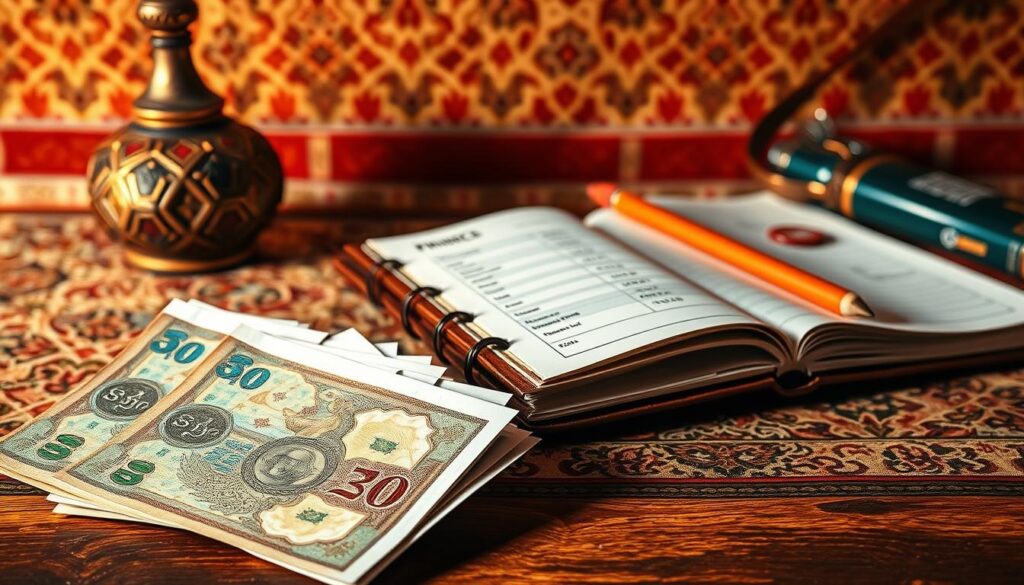
Visa Requirements and Entry Information
Many Western travelers can enter Morocco visa-free for up to 90 days. However, it’s crucial to make sure you check the current visa requirements based on your nationality before your trip. Ensuring you have the necessary documents will make your entry into Morocco smooth.
Packing Essentials for Morocco
When packing for Morocco, consider the climate and cultural norms. Modest clothing is recommended for religious sites, while comfortable shoes are a must for exploring medinas. Layers are also advisable due to temperature variations. Planning your itinerary in advance can help you pack more effectively, ensuring you’re prepared for the way you plan to travel.
Transportation Options in Morocco
Understanding Morocco’s transportation landscape is key to a smooth and enjoyable trip. Morocco offers various ways to get around, catering to different preferences and budgets.
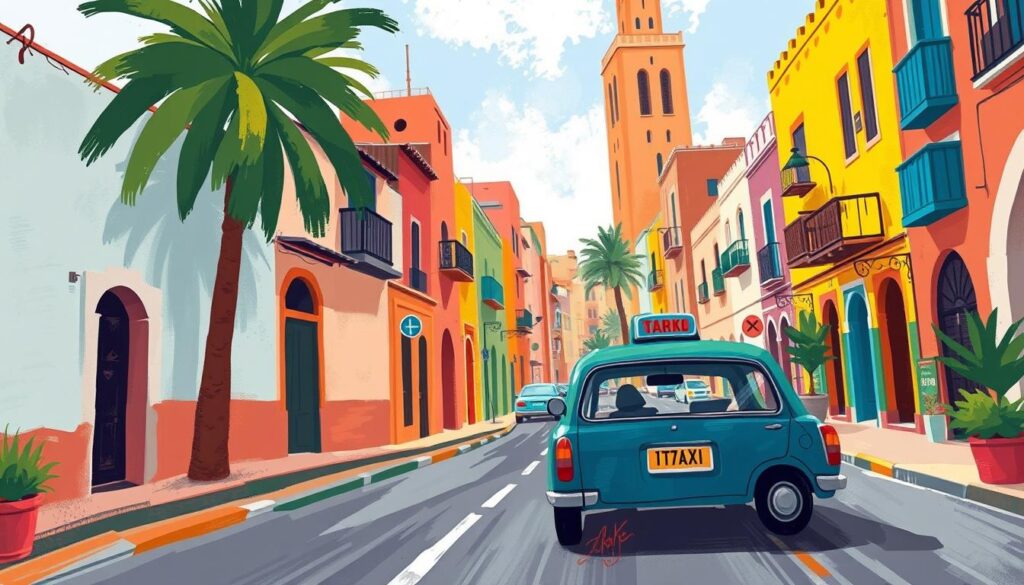
Getting Around Cities
Within cities, taxis are a common mode of transport. There are petit taxis for short, metered rides and grand taxis for shared or private journeys. It’s essential to agree on the fare before you start your journey. A 10-minute drive typically costs around 50 dirhams ($5).
Traveling Between Cities
For inter-city travel, private car transfers are a popular choice, offering comfort and flexibility. Alternatively, you can use trains, which are efficient, especially on the high-speed line connecting major cities like Tangier, Rabat, Casablanca, and Marrakech. Buses are another option, though they may take longer.
Should You Rent a Car?
Renting a car in Morocco can be a good option if you’re comfortable with driving in a foreign country. Moroccan roads are generally manageable, but parking in medinas can be challenging. If you’re not confident driving, hiring a private driver for the day or for multi-day tours is a convenient alternative.
By understanding these transportation options, you can better plan your Moroccan adventure, ensuring that your journey is as enjoyable as the destinations themselves.
Accommodation Guide: Where to Stay During Your 7-Day Morocco Trip
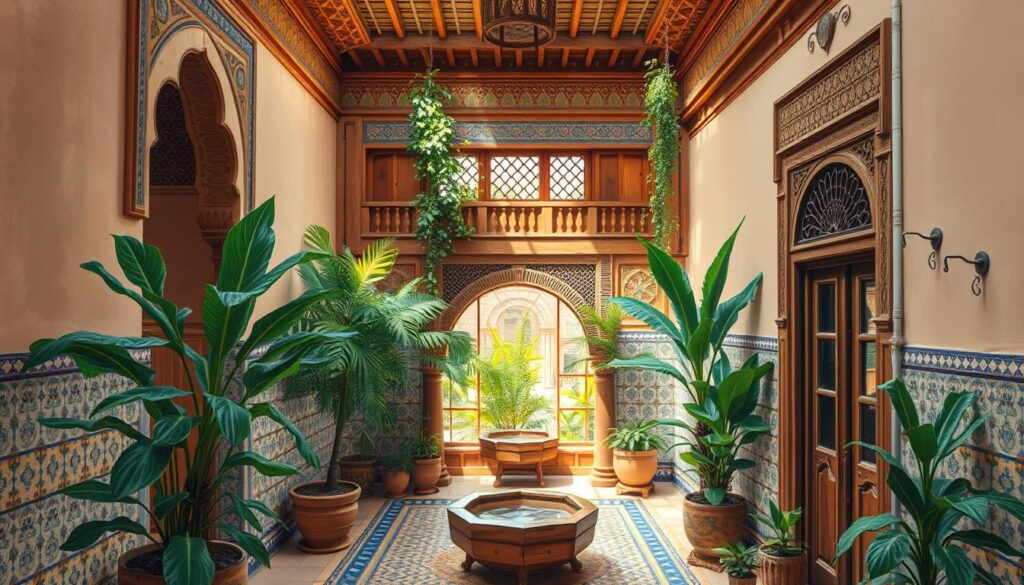
The right place to stay can make all the difference in your Moroccan experience. Morocco offers a diverse range of accommodations, from traditional riads and luxury hotels to desert camps, ensuring that every traveler finds a suitable option.
Traditional Riads: The Authentic Moroccan Experience
Traditional riads are a hallmark of Moroccan architecture, offering an authentic and unique experience. These traditional homes, with their enclosed interior gardens and courtyards, provide a serene escape from the bustling streets of medinas like Marrakech and Fez. Riads such as Riad Ksar Al Amal in Marrakech are highly praised for their incredible service, fresh breakfast, and stunning decor. Staying at a riad allows travelers to immerse themselves in local culture and enjoy personalized service, typically at a price of around $200 USD per night or less.
Luxury Hotels vs. Budget Options
Morocco caters to all budgets with its range of accommodations. Luxury hotels like La Mamounia in Marrakech offer opulent amenities and services, while budget-friendly options provide comfortable stays at affordable prices. Travelers can expect varying levels of service and amenities depending on their budget. For instance, luxury hotels may offer fine dining, spas, and pools, whereas budget options might focus on clean, comfortable rooms and friendly service.
Desert Camps: What to Expect
For those venturing into the Sahara Desert, desert camps offer a unique experience. Luxury desert camps like Desert Luxury Camp in Merzouga provide glamping experiences with private bathrooms and gourmet meals, while more basic camps offer an authentic, rugged experience. Prices can range from around $600 USD for two nights, including private transfers and meals, making for an unforgettable night under the stars.
When choosing where to stay, consider the location, amenities, and value for money. Staying within the medina can offer a more immersive experience, but may come with noise and limited accessibility. In contrast, newer parts of cities may offer more modern amenities but could be farther from main attractions.
Day 1: Arriving in Marrakech – Gateway to Morocco
The moment you arrive in Marrakech, you’re enveloped in a world of color, sound, and scent that is quintessentially Moroccan.

Navigating Marrakech Menara Airport
Upon arrival at Marrakech Menara Airport, you’ll find that many riads or hotels have arranged for a porter to assist with your bags and guide you to your accommodation. It’s a good idea to withdraw some cash at the airport, especially if you’re planning to stay in the medina, as not all vendors may accept credit cards.
To navigate the airport efficiently, consider pre-arranging an airport transfer or familiarizing yourself with the local taxi services. Ensure you have your accommodation details readily available, as you may need to show them to taxi drivers.
Settling into Your Riad
Checking into a traditional riad is an experience in itself. Upon arrival, you’re typically greeted with a warm welcome, often accompanied by a refreshing mint tea service. Your host will likely take the time to explain the neighborhood, provide a map, and offer insights into the local culture and customs.
To combat jet lag on your first day, strike a balance between rest and light exploration. Take some time to relax at your riad, and then venture out for a gentle stroll around the nearby areas to get accustomed to your new surroundings.
First Evening: Jemaa el-Fnaa and Dinner Recommendations
As the day transitions into evening, make your way to the iconic Jemaa el-Fnaa square. This bustling hub transforms into a vibrant night market, filled with street performers, food stalls, and a palpable energy.
For your first dinner in Marrakech, consider dining at Mandala Society, known for its modern Moroccan fusion cuisine that’s also suitable for vegans and vegetarians. It’s advisable to make a reservation in advance to secure your spot.
As you enjoy your meal, take in the surroundings and soak up the atmosphere. The blend of flavors, sounds, and sights will leave you with a lasting impression of your first day in Marrakech.
Day 2: Exploring the Wonders of Marrakech
The second day of your journey in Marrakech promises an enriching experience, blending history, culture, and relaxation. As you explore this vibrant city, you’ll discover its unique charm and hospitality.
Morning: Bahia Palace and Saadian Tombs
Begin your day with a visit to the Bahia Palace, a masterpiece of Moroccan craftsmanship. This 19th-century palace is renowned for its intricate tile work, carved wood, and expansive courtyards adorned with orange trees. To avoid the crowds, plan your visit for the morning, around 9:00 AM. Following your exploration of the palace, head to the Saadian Tombs, a historic site dating back to the 16th century. These tombs are a testament to Moroccan architecture and are best visited during the late morning when the sun casts a golden glow on the intricate designs.
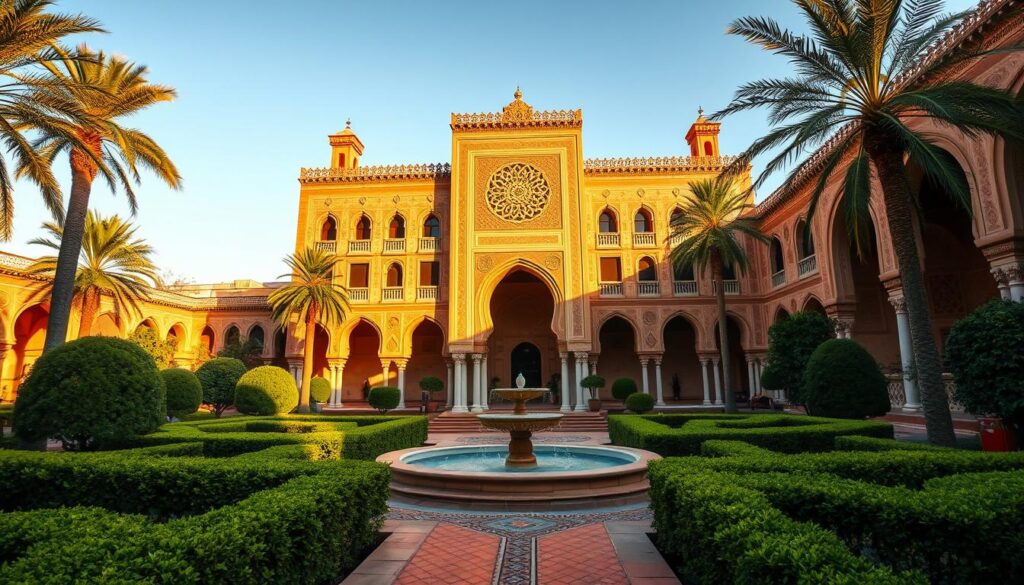
Afternoon: Navigating the Souks
After lunch, immerse yourself in the bustling souks of Marrakech. With numerous alleys and stalls selling everything from spices to handicrafts, it’s easy to get lost in the vibrant atmosphere. Start at the Souk Semmarine, one of the largest and most famous souks, and work your way through the various markets. Be prepared to haggle; starting with 10% of the asking price and being willing to walk away if the seller won’t meet your target price is a good strategy. Remember, the art of haggling is part of the Moroccan shopping experience.
| Item | Average Price | Haggling Tip |
|---|---|---|
| Ceramics | $10-$20 | Start at 30% of the asking price |
| Textiles | $20-$50 | Be prepared to walk away if the price isn’t right |
| Spices | $5-$10 | Buy in bulk to get a better deal |
Evening: Dinner and Relaxation at Your Riad
In the evening, enjoy dinner at one of Marrakech’s renowned restaurants, such as Mandala Society, which offers a blend of traditional Moroccan cuisine and international flavors. After dinner, return to your riad for some relaxation. Many riads offer rooftop views where you can enjoy a mint tea while listening to the call to prayer from the nearby mosque. For a more indulgent experience, consider booking an in-house hammam treatment to soothe your muscles after a day of exploration.
As the day comes to a close, Marrakech’s magic is sure to leave you with unforgettable memories, ready to embark on the next adventure in your Moroccan journey.
Day 3: The Best Morocco Itinerary Continues – From Marrakech to the Atlas Mountains
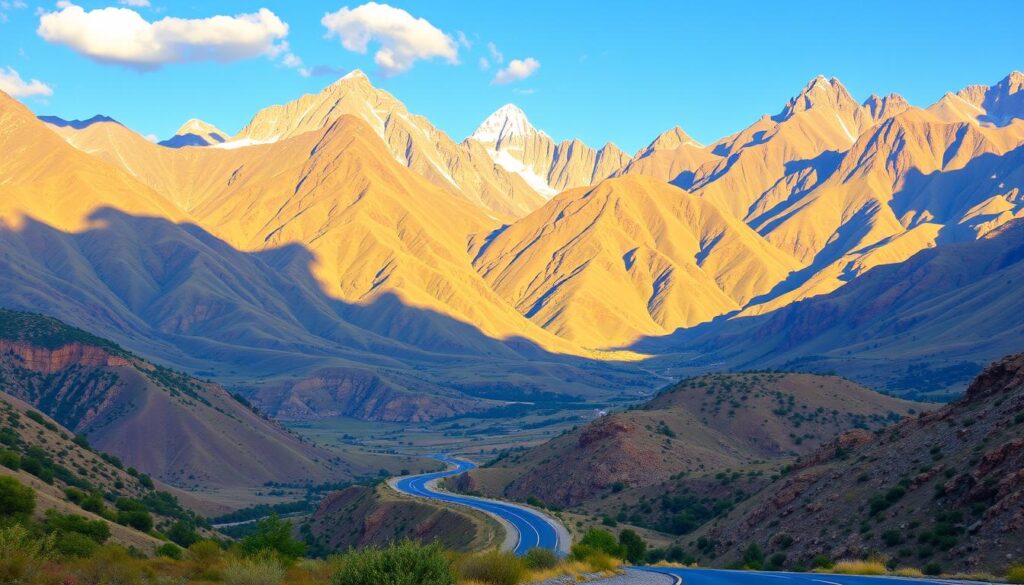
On the third day of your Moroccan adventure, take a drive to the Atlas Mountains, where the beauty of the landscape and the warmth of Berber hospitality await. This day trip from Marrakech is a perfect blend of natural beauty, cultural immersion, and relaxation.
Scenic Drive Through the Atlas Mountains
The drive up to the Atlas Mountains is about an hour and a half, offering breathtaking views of the landscape. With a private driver or tour guide, you’ll stop at viewpoints and enjoy the scenic beauty of the mountains. The journey is as much a part of the experience as the destination.
Visiting Berber Villages
Upon arrival, you’ll visit traditional Berber villages, where you’re welcomed into local homes with lunch and mint tea. This is a unique opportunity to experience authentic Berber culture, watch traditional bread-making, and engage with the community. Some tours include a guided hike to the village, adding a layer of adventure to your visit.
Lunch with Mountain Views
Enjoying lunch with panoramic views of the Atlas Mountains is a highlight of the day. Whether at a rustic local eatery or a more upscale restaurant, the meal is savored against the backdrop of majestic peaks. The way to the lunch spot, often winding through picturesque landscapes, is part of the experience. You might even travel by car or private transfer, adding to the comfort and flexibility of your trip.
As you continue your journey through Morocco, the Atlas Mountains offer a memorable experience that combines natural beauty, cultural richness, and relaxation, making for a well-rounded day trip from Marrakech.
Day 4: Journey to the Sahara Desert
Day 4 is all about the journey, as you travel from Marrakech to the breathtaking Sahara Desert, a trip filled with scenic stops and unforgettable experiences.

The Long Drive: What to Expect
The drive to the Sahara Desert is a significant part of the adventure, spanning approximately 7 to 8 hours. While this may seem daunting, the scenic route is dotted with interesting stops that make the journey enjoyable. Be sure to pack comfortably, bringing along snacks, water, and entertainment for the road. The road conditions vary, but a skilled driver will navigate through the terrain with ease.
To ensure comfort during the long drive, consider bringing a travel blanket, sunglasses, and a hat to protect against the sun.
Stops Along the Way: Ait Ben Haddou and Ouarzazate
Two must-see stops on your way to the Sahara are Ait Ben Haddou and Ouarzazate. Ait Ben Haddou, a UNESCO World Heritage site, is renowned for its ancient earthen architecture, while Ouarzazate is often referred to as Morocco’s “Hollywood” due to its film studios. Take your time to explore these locations, soaking in the history and culture.
Arriving at Your Desert Camp
Upon arriving at your desert camp, you’ll be greeted with warm hospitality. Many camps offer luxury glamping experiences, complete with comfortable accommodations and delicious meals. The journey from the camp’s edge to your accommodation often involves a camel ride, a quintessential desert experience. Be sure to wear comfortable clothing and prepare for the extreme temperatures by packing layers.
For a truly luxurious experience, consider booking a desert camp that offers high-end amenities and services, such as the Desert Luxury Camp in Merzouga, which provides a comprehensive package including private transfers and excellent dining options.
Day 5: Magical Desert Experience and Journey to Fez
Day 5 brings an early morning adventure in the Sahara Desert, where a camel trek at sunrise promises an experience of a lifetime. The tranquility of the desert landscape, coupled with the majestic camels, sets the stage for an unforgettable journey.
Sunrise Camel Trek in the Sahara
Wake up early to witness the breathtaking sunrise over the Sahara dunes. Dress warmly for the cool morning temperatures, and get ready for a serene camel trek across the vast desert expanse. As the sun rises, the dunes are illuminated, offering spectacular photo opportunities. The camel trek is a magical experience that allows you to connect with nature and enjoy the peaceful desert morning.
For those seeking more adventure, activities like sandboarding down the dunes or quad biking offer an adrenaline rush. Alternatively, simply bask in the tranquility of the desert landscape before departing.
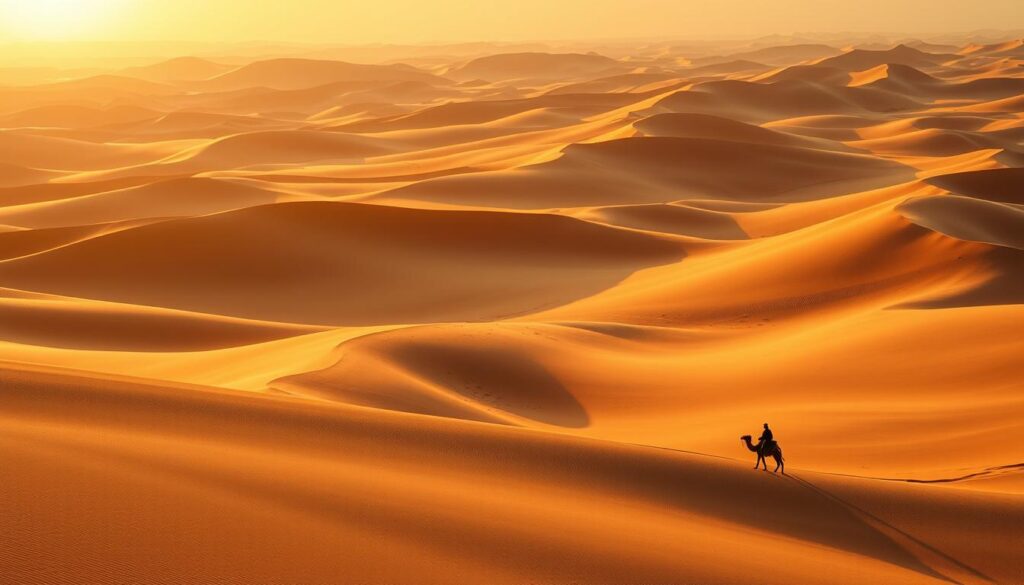
The Drive to Fez: Landscapes and Stops
After an enchanting morning in the Sahara, embark on the drive to Fez, a journey of approximately 7 hours. The drive is punctuated by changing landscapes, from the vast desert to more verdant areas. To make the journey comfortable, consider downloading entertainment, bringing snacks, and arranging rest stops at scenic or culturally significant locations along the way.
Stops at places like Ait Ben Haddou and Ouarzazate provide a glimpse into Morocco’s rich history and culture. These breaks not only make the long drive more enjoyable but also offer opportunities to stretch your legs and appreciate the local scenery.
Evening Arrival in Fez
Upon arriving in Fez in the evening, take some time to settle into your accommodations and unwind. Opt for a relaxing dinner at a nearby restaurant, savoring local cuisine without the need to venture far. A gentle orientation around your accommodation can help prepare you for a full day of exploration in Fez the next day, ensuring you’re ready to dive into the city’s ancient medina and cultural treasures.
Day 6: Discovering the Ancient City of Fez

As you step into Fez, the ancient city’s mystique immediately captivates you. Fez, a city steeped in history, is a must-visit destination on your Moroccan itinerary. The medina, a labyrinth of narrow streets and alleys, is the heart of Fez, and navigating it requires a knowledgeable guide.
Navigating the Fez Medina with a Guide
The Fez medina is the largest car-free urban area in the world, with over 9,000 narrow streets and alleys. It’s very easy to get lost in this convoluted maze, as Google Maps and other GPS tools often fail to provide accurate directions. Hiring a local guide is not just recommended; it’s essential for a meaningful exploration of Fez. A guide will help you uncover the hidden gems and historical significance of the city, making your visit truly unforgettable.
Must-See Attractions: Tanneries and Madrasas
Fez is home to some of Morocco’s most significant historical attractions. The Chouara Tanneries, with their vibrant colors and traditional leatherworking techniques, are a fascinating, albeit smelly, place to visit. Visitors are often handed a sprig of mint to mask the strong odors. The Al-Qarawiyyin University, the world’s oldest, and the intricately decorated madrasas are other must-see attractions. These historical sites showcase the architectural and cultural richness of Fez.
Shopping and Dining in Fez
Fez is renowned for its artisanal crafts, including ceramics, metalwork, textiles, and leather goods. When shopping, be sure to explore the unique quarters where traditional craftspeople work. For food, Fez offers a range of experiences, from street food to fine dining. Local specialties differ from those found in other Moroccan city destinations, making Fez a culinary tour worth taking. Whether you’re looking to indulge in traditional Moroccan cuisine or explore local markets, Fez has something to offer every palate.
Day 7: The Blue City of Chefchaouen
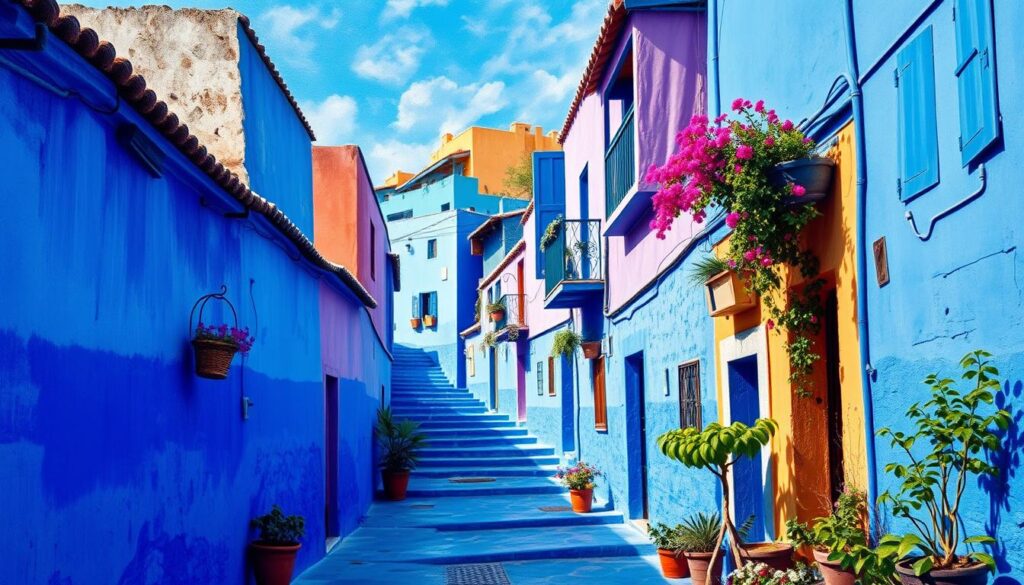
The Blue City of Chefchaouen awaits on Day 7, a picturesque town that offers a serene escape from the bustling streets of Fez. This day trip is a perfect opportunity to experience the tranquil beauty of Morocco’s Rif Mountains.
The Journey to the Blue Pearl
The journey from Fez to Chefchaouen takes approximately 4-5 hours each way by car, making a private driver the recommended transportation option for this day trip. The scenic route winds through the Rif Mountains, offering breathtaking views along the way.
Scenic stops are a must, allowing you to soak in the natural beauty of the region. The drive is as picturesque as the destination, with rolling hills and quaint villages dotting the landscape.
Exploring Chefchaouen’s Blue Streets
In the morning, start your exploration of Chefchaouen at the main plaza, where you can soak in the laid-back atmosphere. Wander through the blue-washed streets of the medina, discovering hidden alleyways and taking in the unique aesthetic of this charming town.
Chefchaouen’s history is reflected in its architecture, with the blue color having both practical and cultural significance. The town is also known for its local handicrafts, including woolen goods and woven blankets, making it a great place to find unique souvenirs.
Return to Fez or Departure Preparations
Timing is crucial for the return journey to Fez, as driving in the mountains after dark is best avoided. Plan your departure from Chefchaouen in the late afternoon to ensure a safe and scenic drive back.
If this is your final day in Morocco, you can skip the return to Fez and instead prepare for your departure, reflecting on the wonderful experiences of your 7-day adventure.
Moroccan Cuisine: What and Where to Eat
Embarking on a culinary journey through Morocco is an adventure in itself, with a plethora of dishes that reflect the country’s cultural heritage. Moroccan cuisine is known for its rich flavors, aromas, and vibrant presentation, making every meal a memorable experience.
Must-Try Moroccan Dishes
Moroccan cuisine offers a variety of dishes beyond the well-known tagine. Some must-try dishes include pastilla, a savory pie made with layers of flaky pastry, meat, and spices; couscous, typically served on Fridays and made with semolina flour; harira, a hearty soup that is a staple during Ramadan; and various Moroccan salads that combine fresh vegetables, fruits, and nuts. Regional specialties can be found in different cities, showcasing the diversity of Moroccan cuisine.
| Dish | Description | Region |
|---|---|---|
| Tagine | Slow-cooked stew named after the conical clay pot it’s cooked in | Marrakech |
| Pastilla | Savory pie made with layers of flaky pastry, meat, and spices | Fez |
| Couscous | Traditional dish made with semolina flour, typically served on Fridays | Various |
Dining Etiquette in Morocco
Understanding local dining customs can enhance your culinary experience. In Morocco, it’s customary to wash your hands before and after meals. Meals are often eaten communally, with diners sharing food from a central dish using their right hand. Mint tea is a staple beverage, ceremoniously poured from height to create bubbles, symbolizing hospitality and respect for guests.
Restaurant Recommendations Across Your Itinerary
During your 7-day Morocco trip, you’ll have the opportunity to dine at various restaurants that showcase the best of Moroccan cuisine. In Marrakech, recommended restaurants include Mandala Society for modern Moroccan fusion, Terrasse des Epices for traditional tagines with rooftop views, and Le Comptoir for traditional food accompanied by belly dancing shows. Be sure to try local eateries in Fez and Chefchaouen as well, where you can enjoy authentic Moroccan dishes in cozy settings.
For those with dietary restrictions, Morocco offers options for vegetarians, vegans, and those with gluten sensitivities. Many restaurants are accommodating, and it’s advisable to communicate your dietary needs clearly. Additionally, consider participating in food tours, cooking classes, and market visits to gain a deeper understanding of Moroccan ingredients and cooking techniques.
Shopping in Morocco: Souvenirs and Haggling Tips
As you explore Morocco, you’ll discover that shopping is not just about buying things; it’s an immersive cultural experience that allows you to engage with local artisans and understand the significance of traditional crafts.
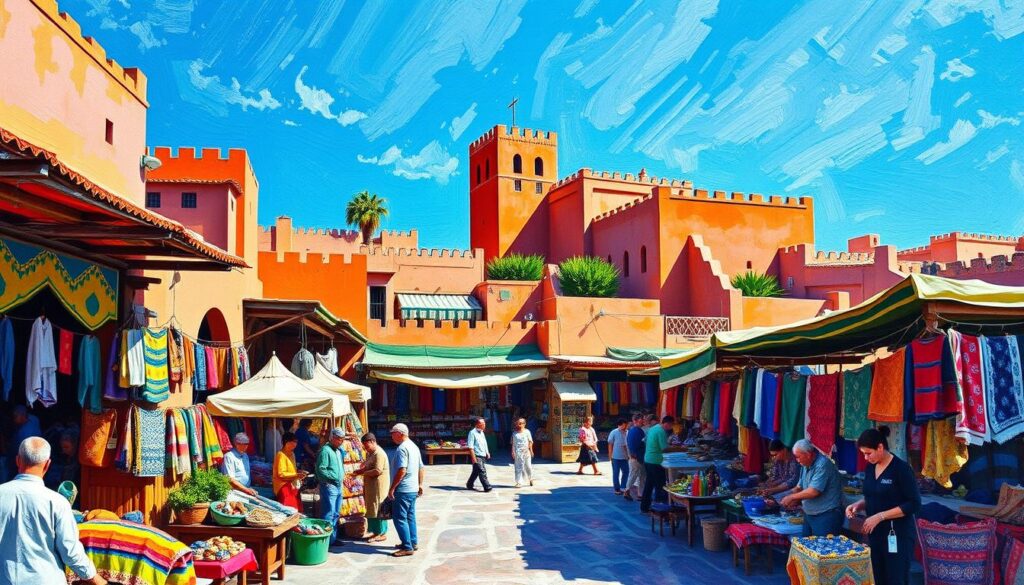
Navigating the Souks: What to Buy Where
Morocco’s cities specialize in different products, making each destination unique. In Marrakech, you’ll find a vast array of goods, from colorful textiles to intricate metalwork. Fez is renowned for its ceramics and leather goods, while Chefchaouen is the place to visit for woven products and authentic Berber crafts.
When shopping, take your time to explore various souks and stalls. The souks contain both new and old things, and you can easily spend a lot of time there, losing track of time as you browse through the numerous offerings.
The Art of Haggling in Moroccan Markets
Haggling is an expected part of the shopping experience in Morocco. To make sure you get a fair price, it’s advisable to start by offering half of the initial asking price. This way, you can negotiate to a mutually agreeable amount. Remember, the key is to be respectful and enjoy the process, as haggling is a significant aspect of the local culture.
Practice your negotiation skills on smaller items first, and don’t be afraid to walk away if the price isn’t right. This approach will help you navigate the markets with confidence and secure a good price for the things you want to buy.
Shipping Options for Larger Purchases
For larger purchases, shipping can be a convenient option. Many shops offer shipping services, but it’s essential to research reliable shipping companies to ensure your items arrive safely. Consider the cost and customs considerations when deciding on shipping, and make sure to ask about the estimated delivery time.
If you have multiple purchases, you might also look into shipping consolidators as a cost-effective way to send your goods home. This can be particularly useful if you’re buying from various vendors across different locations.
Cultural Tips and Etiquette for Travelers
As you prepare for your Moroccan adventure, learning about cultural norms can significantly enhance your experience. Morocco is a country rich in traditions and customs, and being respectful of these can make a significant difference in your interactions with the local people.
Dress Code and Respectful Behavior
Dressing modestly is advised, particularly for women, who should cover their shoulders and knees as a sign of respect. In cities and rural areas, light, casual clothing is appropriate, while visiting religious sites may require additional covering. Understanding and adhering to these dress codes can help you navigate different settings with confidence.
- Wear loose, comfortable clothing that covers your shoulders and knees.
- Consider the local culture when choosing what to wear, especially when visiting mosques or rural areas.
- Lightweight clothing is advisable due to the climate, but ensure it’s modest.
Photography Etiquette
When it comes to photography, it’s essential to be respectful. Asking permission before taking someone’s picture is not just polite; it’s often required. Some locations, like the tanneries in Fez, are visually striking but may not be appropriate for photography due to the working conditions. Being mindful of these nuances can help you capture memories without offending locals.
Interacting with Locals
Interacting with Moroccans can be a highlight of your trip. While you might encounter some heckling in the medina, it’s advised not to take it personally. Learning a few basic phrases in Arabic or French, such as greetings, can go a long way in showing respect for the local culture.
- Learn basic Arabic or French phrases to greet locals.
- Be prepared for interactions in the medina and remain calm.
- Understand that bargaining is part of the culture, and tipping is appreciated for good service.
By being aware of and respecting local customs, you can have a more meaningful and enjoyable tour of Morocco. This cultural sensitivity will not only enhance your experience but also contribute to a positive interaction between you and the people you meet along the way.
Safety Tips and Practical Advice
As you plan your Moroccan adventure, understanding the safety concerns and practical advice can significantly enhance your experience. Morocco is generally a safe country, but like many popular tourist destinations, it’s not without its challenges.
Staying Safe in Moroccan Cities
Navigating the maze-like medinas in Moroccan cities can be daunting, especially in Fez where Google Maps may not work effectively. To avoid getting lost, consider hiring a guide who is familiar with the area. Additionally, be mindful of pickpocketing in crowded areas and use ATMs securely. Solo travelers and women should take extra precautions, such as avoiding traveling alone at night and using reputable transportation services.
It’s also a good idea to stay informed about local conditions and follow local advice. By being aware of your surroundings and taking necessary precautions, you can have a safe and enjoyable experience in Moroccan cities.
Health Considerations and Travel Insurance
Before traveling to Morocco, make sure you have the necessary vaccinations and take precautions against food and water-borne illnesses. It’s also crucial to have comprehensive travel insurance that covers medical expenses. If you do fall ill, know that healthcare services are available, though the quality can vary.
Dealing with Persistent Vendors and Guides
When dealing with persistent vendors and unofficial guides, it’s essential to be firm but polite. A simple “no thank you” can go a long way. Be aware of common scams and know when to seek assistance from official sources. By being prepared, you can minimize unwanted interactions and enjoy a smoother tour of Morocco.
By following these safety tips and practical advice, you can ensure a more enjoyable and stress-free journey through Morocco.
Conclusion: Making the Most of Your 7-Day Moroccan Adventure
As you conclude your 7-day Moroccan escapade, the memories of vibrant souks, tranquil riads, and majestic dunes will linger, a testament to the country’s diverse charm. This 7-day Morocco itinerary has been carefully curated to provide a perfect blend of cultural immersion, natural wonders, and authentic experiences, ensuring that your trip is both memorable and enriching.
The journey from Marrakech’s bustling streets to the serene Sahara Desert, and then to the ancient city of Fez, offers a comprehensive taste of Morocco’s multifaceted identity. However, travelers may wish to modify this itinerary based on their interests. For instance, extending your time in the Sahara could provide a deeper connection with the desert’s tranquility, or adding a visit to the coastal town of Essaouira might offer a refreshing seaside respite.
Among the quintessential Moroccan experiences not to miss are watching the sunset over the Sahara dunes, sipping mint tea in a traditional riad courtyard, and navigating the labyrinthine ancient medinas. These moments, filled with sensory delights, will become the highlights of your trip. Moreover, embracing the unexpected aspects of Moroccan travel, such as spontaneous invitations or transportation delays, can often lead to the most memorable moments of your journey.
As you reflect on your day-to-day experiences, it’s also important to consider the impact of your visit. Practicing responsible and respectful tourism ensures that local communities are supported and Morocco’s cultural heritage is preserved for future generations. By doing so, you contribute to making this beautiful country sustainable for travelers to come.
In conclusion, your 7-day adventure in Morocco is a journey of discovery, not just of the country’s landmarks and landscapes, but also of its people and their way of life. As you visit and experience the various facets of Morocco, you become a part of its ongoing story, leaving behind a positive footprint and taking with you memories that will last a lifetime.